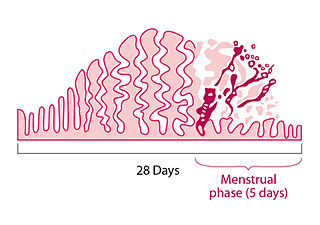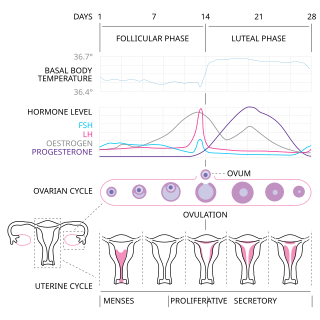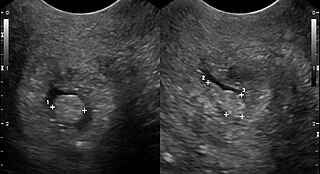Related Research Articles

The combined oral contraceptive pill (COCP), often referred to as the birth control pill or colloquially as "the pill", is a type of birth control that is designed to be taken orally by women. It is the oral form of combined hormonal contraception. The pill contains two important hormones: a progestin and estrogen. When taken correctly, it alters the menstrual cycle to eliminate ovulation and prevent pregnancy.

Menstruation is the regular discharge of blood and mucosal tissue from the inner lining of the uterus through the vagina. The menstrual cycle is characterized by the rise and fall of hormones. Menstruation is triggered by falling progesterone levels, and is a sign that pregnancy has not occurred.

The menstrual cycle is a series of natural changes in hormone production and the structures of the uterus and ovaries of the female reproductive system that makes pregnancy possible. The ovarian cycle controls the production and release of eggs and the cyclic release of estrogen and progesterone. The uterine cycle governs the preparation and maintenance of the lining of the uterus (womb) to receive an embryo. These cycles are concurrent and coordinated, normally last between 21 and 35 days, with a median length of 28 days. Menarche usually occurs around the age of 12 years; menstrual cycles continue for about 30–45 years.

Ovulation is an important part of the menstrual cycle in female vertebrates where the egg cells are released from the ovaries as part of the ovarian cycle. In female humans ovulation typically occurs near the midpoint in the menstrual cycle and after the follicular phase. Ovulation is stimulated by an increase in luteinizing hormone (LH). The ovarian follicles rupture and release the secondary oocyte ovarian cells.
Heavy menstrual bleeding (HMB), previously known as menorrhagia or hematomunia, is a menstrual period with excessively heavy flow. It is a type of abnormal uterine bleeding (AUB).

Adenomyosis is a medical condition characterized by the growth of cells that proliferate on the inside of the uterus (endometrium) atypically located among the cells of the uterine wall (myometrium), as a result, thickening of the uterus occurs. As well as being misplaced in patients with this condition, endometrial tissue is completely functional. The tissue thickens, sheds and bleeds during every menstrual cycle.

Vaginal bleeding is any expulsion of blood from the vagina. This bleeding may originate from the uterus, vaginal wall, or cervix. Generally, it is either part of a normal menstrual cycle or is caused by hormonal or other problems of the reproductive system, such as abnormal uterine bleeding.

An endometrial polyp or uterine polyp is a mass in the inner lining of the uterus. They may have a large flat base (sessile) or be attached to the uterus by an elongated pedicle (pedunculated). Pedunculated polyps are more common than sessile ones. They range in size from a few millimeters to several centimeters. If pedunculated, they can protrude through the cervix into the vagina. Small blood vessels may be present, particularly in large polyps.

Tranexamic acid is a medication used to treat or prevent excessive blood loss from major trauma, postpartum bleeding, surgery, tooth removal, nosebleeds, and heavy menstruation. It is also used for hereditary angioedema. It is taken either by mouth, injection into a vein, or by intramuscular injection.
Intermenstrual bleeding (IMB), or metrorrhagia, is vaginal bleeding at irregular intervals between expected menstrual periods. It may be associated with bleeding with sexual intercourse. The term metrorrhagia, in which metro means measure and -rrhagia means abnormal flow, is no longer recommended.
Menometrorrhagia, also known as heavy irregular menstrual bleeding, is a condition in which prolonged or excessive uterine bleeding occurs irregularly and more frequently than normal. It is thus a combination of metrorrhagia and menorrhagia.

A menstrual disorder is characterized as any abnormal condition with regards to a woman's menstrual cycle. There are many different types of menstrual disorders that vary with signs and symptoms, including pain during menstruation, heavy bleeding, or absence of menstruation. Normal variations can occur in menstrual patterns but generally menstrual disorders can also include periods that come sooner than 21 days apart, more than 3 months apart, or last more than 10 days in duration. Variations of the menstrual cycle are mainly caused by the immaturity of the hypothalamic-pituitary-ovarian (HPO) axis, and early detection and management is required in order to minimize the possibility of complications regarding future reproductive ability.
Polymenorrhea, also known as frequent periods, frequent menstruation, or frequent menstrual bleeding, is a menstrual disorder in which menstrual cycles are shorter than 21 days in length and hence where menstruation occurs more frequently than usual. Cycles are regular and menstrual flow is normal in the condition. Normally, menstrual cycles are 25 to 30 days in length, with a median duration of 28 days.

A cervical polyp is a common benign polyp or tumour on the surface of the cervical canal. They can cause irregular menstrual bleeding but often show no symptoms. Treatment consists of simple removal of the polyp and prognosis is generally good. About 1% of cervical polyps will show neoplastic change which may lead to cancer. They are most common in post-menarche, pre-menopausal women who have been pregnant.
Hypomenorrhea or hypomenorrhoea, also known as short or scanty periods, is extremely light menstrual blood flow. It is the opposite of heavy periods or hypermenorrhea which is more properly called menorrhagia.

Postcoital bleeding (PCB) is non-menstrual vaginal bleeding that occurs during or after sexual intercourse. Though some causes are with associated pain, it is typically painless and frequently associated with intermenstrual bleeding.

The International Federation of Gynecology and Obstetrics is an international organization that links about 125 international professional societies of Obstetricians and Gynecologists. In 2011 FIGO recognized two systems designed to aid research, education, and clinical care of women with abnormal uterine bleeding (AUB) in the reproductive years. This page is a summary of the systems and their use in contemporary gynecology.
Menstrual suppression refers to the practice of using hormonal management to stop or reduce menstrual bleeding. In contrast to surgical options for this purpose, such as hysterectomy or endometrial ablation, hormonal methods to manipulate menstruation are reversible.
Metropathia haemorrhagica, also known as metropathia haemorrhagica cystica, is a menstrual disorder which is defined as a specialized type of anovulatory dysfunctional uterine bleeding associated with endometrial hyperplasia and intermenstrual bleeding. The condition was defined by 1930. It has been agreed that the term "metropathia haemorrhagica" should be discarded along with many other older terms for menstrual disorders. Due to diffuse polyposis
Oligoamenorrhea, also known as irregular infrequent periods or irregular infrequent menstrual bleeding, is a collective term to refer to both oligomenorrhea and amenorrhea. It is a menstrual disorder in which menstrual bleeding occurs on an infrequent and irregular basis. Menstrual intervals are 37 to 180 days in oligoamenorrhea. Nearly 90% of women with oligoamenorrhea have polycystic ovary syndrome (PCOS).
References
- ↑ Sulochana Gunasheela (14 March 2011). Practical Management of Gynecological Problems. JP Medical Ltd. pp. 21–. ISBN 9789350252406. OCLC 754739927.
- ↑ Owen Epstein; G. David Perkin; John Cookson; Ian S. Watt; Roby Rakhit; Andrew W. Robins; Graham A. W. Hornett (7 July 2008). Clinical Examination E-Book (4 ed.). Elsevier Health Sciences. pp. 239–. ISBN 978-0-7234-3605-8. OCLC 1017806626.